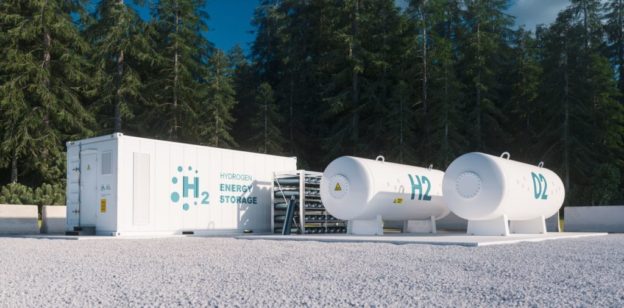There is growing excitement around the world about the potential of green hydrogen as a major energy carrier in our clean energy transition, and for good reason. A kilogram of hydrogen holds more chemical energy than any other fuel and burns cleanly. This gives hydrogen the potential to be a direct substitute for fossil fuels in myriad fossil fuel applications and moves us further toward net-zero emission goals.
“Clean hydrogen is key to cleaning up American manufacturing and slashing emissions from carbon-intensive materials like steel and cement while creating good-paying jobs,” U.S. Energy Secretary Jennifer Granholm said in an announcement of new Department of Energy (DOE) programs to accelerate progress and reduce the cost of producing hydrogen.
However, global production of hydrogen is small – 90 million tons per year, according to DOE. That compares to the 4.2 billion tons of crude oil produced per year; that is over 50 times more. Producing hydrogen is an extremely energy intensive process – one ton of hydrogen requires the energy equivalent to the combustion of 5 tons of oil (32 barrels), and that presents the challenge – the double objective of scaling up hydrogen supply and doing so cleanly.
The predominant way we manufacture hydrogen today is to use natural gas as a feedstock and burning fossil fuels to add energy; this is both energy efficient and inexpensive – but we cannot increase our CO2 footprint to make hydrogen. That would be environmentally absurd. As absurd as running an electric vehicle with coal-fired electric power generation.
The vision for hydrogen in a clean and prosperous net-zero economy requires energy and cost efficiency, and environmentally responsible methods to make hydrogen. There are a variety of methods: steam methane reforming with Carbon Capture, methane pyrolysis, electrolysis or high-temperature electrolysis. It will be companies with expertise in industrial chemistry and production to select the method and those methods undoubtedly will be use-and site-specific.
However, all methods have huge energy budgets, and those budgets must be met with clean energy. High-temperature thermal energy supply is essential for the subset of methods that are energy and cost efficient. For example, high-temperature steam electrolysis is 20% to 40% more energy efficient than conventional electrolysis, and by extension, cost– efficient as energy is money and money is energy.
Without high-temperature thermal energy, hydrogen will be unnecessarily expensive. Where do we get huge quantities of thermal and electric energy without burning fossil fuels?
Generation IV Nuclear and Green Hydrogen Production Costs
Generation IV fission technology, such as Terrestrial Energy’s IMSR® Generation IV fission power plant, is ideally suited for hydrogen production as it produces thermal energy at 600 degrees C, which is the thermal energy necessary. With the IMSR® power plant we have a source of clean thermal energy that is relevant for those energy and cost-efficient hydrogen production methods, and it has enormous clean energy muscle.
In addition, with 600 degrees C thermal energy supply, an IMSR® Generation IV fission power plant will generate electric power 50% more efficiently than Conventional Nuclear plants; these use low temperature water-cooled and moderated reactor technology. In other words, the IMSR®’s high operating temperature translates into much better electric power generation economics as well. We should recall that hydrogen production requires a lot of electric power.
It is these capabilities and economics that put high-temperature electrolysis into play. IMSR® thermal energy, at a heat quality of 600 degrees C, costs less than $6 per MMBTU, and can produce electric power at less than $50 per MWh. These two energy streams when coupled to high-temperature electrolysis produce clean hydrogen at about $1.70 to $2.20 per kg of hydrogen from a 250-tonnes-a-day plant.
Today’s dominant method of hydrogen production – steam methane reforming without carbon capture, which accounts for 95% of world output – is CO2 intensive. It emits more that 9.3 kg CO2 per kg hydrogen produced[1], which is becoming an actual cost with the coming carbon penalties.
The production of hydrogen from natural gas with carbon capture and storage, so called blue hydrogen, is an alternative solution to reduce carbon penalties. According to a 2021 study[2] by Global CCS Institute, production of blue hydrogen has an estimated cost of $1.40 to $2.50 per kg of hydrogen.

The estimated production cost is highly sensitive to gas prices. The study suggests that the production of blue hydrogen is significantly constrained by the availability of geological storage resources. Besides, energy security and support for non-fossil fuel solutions make blue hydrogen a less viable option in many places.
With this price range, the IMSR® shows great potential to enable the energy and cost-efficient methods of green hydrogen production and therefore enable many lower carbon industrial pathways, such as those to green ammonia and green steel production.
There is another interesting path from green and cost-competitive hydrogen: We could use it as a coke replacement for refining clean and high-grade steels and other metals. This is the pathway that brings steels production back to locations such as West Virginia, but the steel that returns is clean, near-zero emissions and premium grade in world markets.
The costs, scalability, flexibility and efficiencies offered by IMSR® Generation IV technology enable alternative and competitive methods of green hydrogen production. The demands of green hydrogen production call for Generation IV fission’s unique qualities as a source of near-zero emissions baseload thermal energy. This is critical in view of the billions of tons of hydrogen we need for our net-zero future.
Low-temperature technologies like renewables and even Conventional Nuclear Plants will play a role but cannot lead us to the hydrogen-based, prosperous carbon-free future we seek. It’s Generation IV fission technologies that get us there. It is Terrestrial Energy’s IMSR® technology that can get us there at low cost and starting today.
[1] https://www.forbes.com/sites/rrapier/2020/06/06/estimating-the-carbon-footprint-of-hydrogenproduction/
[2] https://www.globalccsinstitute.com/wp-content/uploads/2021/04/Circular-Carbon-Economy-series-Blue-Hydrogen.pdf
https://www.terrestrialenergy.com/2022/03/01/generation-4-fission-technology-changes-equation-on-green-hydrogen/?action=profile_completion&





